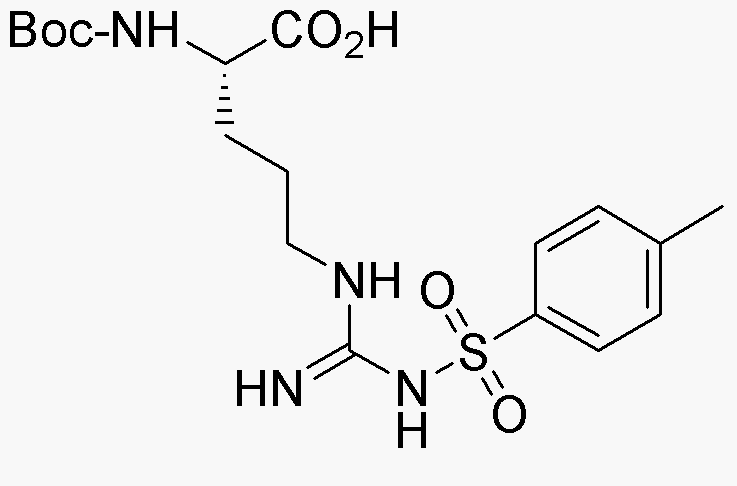Na-Boc-Nw-4-toluenesulfonyl-L-arginine is widely utilized in research focused on:
- Peptide Synthesis: This compound serves as a protecting group in the synthesis of peptides, allowing for selective reactions without interference from other functional groups. This is particularly beneficial in the pharmaceutical industry for creating complex peptide-based drugs.
- Bioconjugation: It is used in bioconjugation processes, where biomolecules are linked to other molecules, enhancing the development of targeted drug delivery systems. This application is crucial in the field of biotechnology and personalized medicine.
- Enzyme Inhibition Studies: Researchers utilize this compound to study enzyme inhibition mechanisms, providing insights into metabolic pathways and potential therapeutic targets, which is vital for drug discovery.
- Diagnostic Reagents: The compound can be employed as a reagent in diagnostic tests, particularly in assays that require specific binding interactions, thus improving the accuracy of medical diagnostics.
- Research on Protein Interactions: It aids in the investigation of protein-protein interactions, helping scientists understand cellular processes and disease mechanisms, which is essential for developing new therapeutic strategies.
Informations générales
Propriétés
Sécurité et réglementation
Applications
Na-Boc-Nw-4-toluenesulfonyl-L-arginine is widely utilized in research focused on:
- Peptide Synthesis: This compound serves as a protecting group in the synthesis of peptides, allowing for selective reactions without interference from other functional groups. This is particularly beneficial in the pharmaceutical industry for creating complex peptide-based drugs.
- Bioconjugation: It is used in bioconjugation processes, where biomolecules are linked to other molecules, enhancing the development of targeted drug delivery systems. This application is crucial in the field of biotechnology and personalized medicine.
- Enzyme Inhibition Studies: Researchers utilize this compound to study enzyme inhibition mechanisms, providing insights into metabolic pathways and potential therapeutic targets, which is vital for drug discovery.
- Diagnostic Reagents: The compound can be employed as a reagent in diagnostic tests, particularly in assays that require specific binding interactions, thus improving the accuracy of medical diagnostics.
- Research on Protein Interactions: It aids in the investigation of protein-protein interactions, helping scientists understand cellular processes and disease mechanisms, which is essential for developing new therapeutic strategies.
Documents
Fiches de données de sécurité (FDS)
La FDS fournit des informations de sécurité complètes sur la manipulation, le stockage et l’élimination du produit.
Spécifications du produit (PS)
Le PS fournit une description complète des propriétés du produit, notamment sa composition chimique, son état physique, sa pureté et les exigences de stockage. Il détaille également les plages de qualité acceptables et les applications prévues du produit.
Certificats d'analyse (COA)
Recherchez des certificats d'analyse (COA) en saisissant le numéro de lot du produit. Les numéros de lot et de lot se trouvent sur l'étiquette d'un produit, après les mots « Lot » ou « Lot de fabrication ».
Numéro de catalogue
Numéro de lot/série
Certificats d'origine (COO)
Ce certificat d'exploitation confirme le pays dans lequel le produit a été fabriqué, et détaille également les matériaux et composants utilisés et s'il est issu de sources naturelles, synthétiques ou autres sources spécifiques. Ce certificat peut être requis pour les douanes, le commerce et la conformité réglementaire.
Numéro de catalogue
Numéro de lot/série
Fiches de données de sécurité (FDS)
La FDS fournit des informations de sécurité complètes sur la manipulation, le stockage et l’élimination du produit.
DownloadSpécifications du produit (PS)
Le PS fournit une description complète des propriétés du produit, notamment sa composition chimique, son état physique, sa pureté et les exigences de stockage. Il détaille également les plages de qualité acceptables et les applications prévues du produit.
DownloadCertificats d'analyse (COA)
Recherchez des certificats d'analyse (COA) en saisissant le numéro de lot du produit. Les numéros de lot et de lot se trouvent sur l'étiquette d'un produit, après les mots « Lot » ou « Lot de fabrication ».
Numéro de catalogue
Numéro de lot/série
Certificats d'origine (COO)
Ce certificat d'exploitation confirme le pays dans lequel le produit a été fabriqué, et détaille également les matériaux et composants utilisés et s'il est issu de sources naturelles, synthétiques ou autres sources spécifiques. Ce certificat peut être requis pour les douanes, le commerce et la conformité réglementaire.


